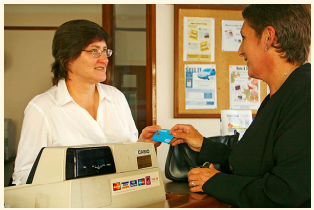8.2: Trailblazer
- Page ID
- 134168
Analytical Report Trailblazer: Barbara Ehrenreich

"As a journalist, I search for the truth."
Figure \(8.2\) Barbara Ehrenreich (https://openstax.org/r/barbaraehrenrich) worked as a waitress as part of her research for Nickel and Dimed: On (Not) Getting By in America (2001). (credit: “Customer service” by Alan Cleaver/ flickr, CC BY 2.0)
Myth-Buster
Self-described “myth buster by trade” Barbara Ehrenreich (b. 1941) has tackled many myths during her years as an activist and a writer, most often confronting widely held beliefs related to health and wealth.
Ehrenreich was born in 1941 in Butte, Montana, the daughter of a copper miner who finished college after she and her siblings were born. The family moved frequently when Ehrenreich was young and finally settled in Los Angeles. Ehrenreich attended Reed College in Portland, Oregon, and went to graduate school at Rockefeller University in New York City, where she earned a PhD in cell biology. Ehrenreich became involved in the women’s health movement in the 1970s and at that point decided to become a full-time writer. Her work life settled into three tracks: “journalism, . . . book-length projects on subjects, . . . [and] activism.” Over her long career, she has written for magazines and newspapers and has published more than 20 books, the most recent of which is Natural Causes: An Epidemic of Wellness, the Certainty of Dying, and Killing Ourselves to Live Longer (2018).
Ehrenreich is perhaps best known for Nickel and Dimed: On (Not) Getting By in America (2001), a first-person account of her three-month experiment trying to make ends meet on minimum wage. She went undercover, leaving her middle-class home behind, and moved around the United States from Florida to Maine to Minnesota. Ehrenreich worked as a waitress, hotel maid, house cleaner, nursing home aide, and Walmart salesperson. On the wages and tips she made at her various jobs, she attempted to find healthy food, health care, and affordable housing in trailer parks and residential hotels.
In Nickel and Dimed, Ehrenreich busts the myth that poor people have figured out how to live well on less money than middle-class people. No such “secret economies” exist, Ehrenreich writes. Instead, poor people pay “a host of special costs,” whether for renting a room by the week because they cannot save up two months’ rent to get an apartment, buying restaurant food because the weekly room doesn’t have a stove, or going to the emergency room for a toothache because they can’t afford to go to the dentist.
As a piece of writing, Nickel and Dimed falls into the genre of memoir. However, the book is also a report; Ehrenreich conducted extensive on-the-ground field research, recording the tasks she performed at her jobs, interactions with managers, and conversations with coworkers about their lives. She recorded her findings when she was not working. Although some readers have criticized Ehrenreich for not being honest about her background and education, most have praised the light she shines on the other side of American prosperity—the people who work hard but who never manage to get ahead. Her work as a “myth buster” toexpose the hardships faced by poor working people in America illustrates the problem of accepting opinions as facts.
In the introduction to Nickel and Dimed, Ehrenreich describes the research methods. She also discusses Nickel and Dimed on C-Span (https://openstax.org/r/C-span).
Discussion Questions
- What does Barbara Ehrenreich mean when she describes herself as a “myth buster”? If you were to bust a myth, what would it be?
- What facts do you think Ehrenreich discovered during her time working undercover? What opinions do you think she formed?
- What do you think were Ehrenreich’s sources of information, and how did she obtain such information?
- If you went undercover to investigate and report on an issue that you think people should know about, what would it be? How would you go about your undercover reporting?
- Could someone live on minimum wage in your community? What information about the cost of housing, food, transportation, and medical care would you need to answer the question? How could you find it?


